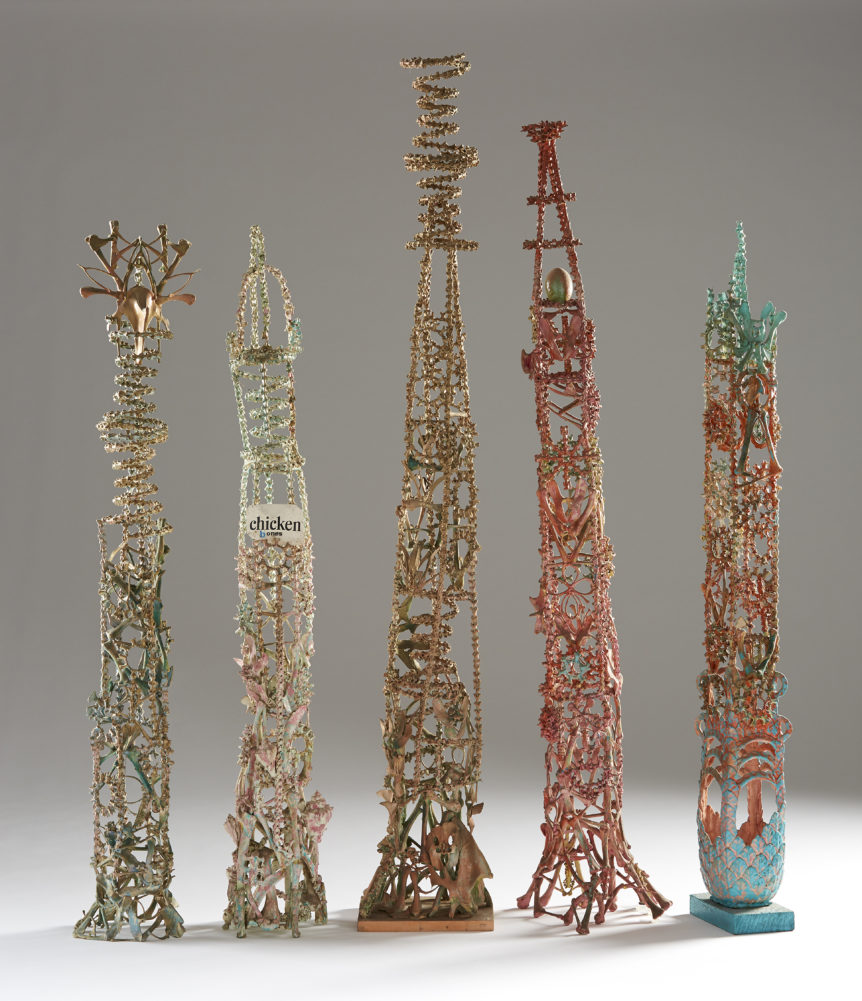
Untitled (bone chair) by Eugene Von Bruenchenhein, c. 1965–1970. All works courtesy John Michael Kohler Arts Center Collection; photograph by Rich Maciejewski.
Last month saw the opening of Mythologies: Eugene Von Bruenchenhein at the John Michael Kohler Arts Center in Sheboygan, Wisconsin, part of The Road Less Traveled exhibition series marking the fiftieth anniversary of the center’s founding. The show is one of fifteen—based around a group of artists that includes Mary Nohl, David Butler, Stella Waitzkin, Emery Blagdon, Loy Bowlin, Dr. Charles Smith, and Jesse Howard—that serves to recapitulate the mission of this off-the-beaten-path arts center: to bring attention to artists who for one reason or another haven’t—or hadn’t—made it into the mainstream.

Untitled (bone towers) by Von Bruenchenhein, c. 1970–1980.
Eugene Von Bruenchenhein was one of the hadn’ts. Now, having been the subject of a retrospective at the American Folk Art Museum in New York and having appeared in a slew of shows in major US and European cities over the last five years, Von Bruenchenhein is, by any estimation, experiencing something of a career moment. Or he would have been if he’d lived long enough to see it. He died in 1983, three years before the return of Halley’s Comet, which had showered the inner solar system with stardust the year he was born, 1910. The comet was key to Von Bruenchenhein’s sense of self. Along with the Von in his name (which he believed linked him to Old World nobility), it forged the conviction that he was destined for deeds of cosmic proportions. For the better part of his life—the part that wasn’t spent eking out an existence as a florist and baker—the high school dropout with big dreams fabricated the appurtenances of a fantastical kingship in the small Milwaukee house he shared with his wife, Marie. “Freelance Artist—Poet and Sculptor—Inovator [sic]— Arrow maker and Plant man—Bone artifacts constructor—Photographer and Architect—Philosopher,” he inscribed on a plaque that hung in his kitchen. By the time he died, his output tallied thousands of artworks, including chicken- and turkey-bone towers and thrones; incense burners made out of ceramic leaves; garishly colored nuclear-holocaust scenes painted using combs, fingers, and brushes made from his wife’s hair; and a trove of charming conjugal erotica—a concentrated universe of art.

No 701 by Von Bruenchenhein, 1958.
Von Bruenchenhein had tried without success to get gallery representation, and after his death a police officer friend shopped his work to the Milwaukee Art Museum. When nobody there wanted it, it fell to the Kohler Arts Center, which mounted his first museum exhibition in 1984 and holds the largest collection of Von Bruenchenheins in the world, as well as his archive of writings.

Untitled (sensor [sic] pot) incense burner by Von Bruenchenhein, c. 1960–1980.

Production Friday July 28-1978 Liberty Complex in the clouds The Age of colored stone and steel by Von Bruenchenhein, 1978.
Mythologies: Eugene Von Bruenchenhein • to January 14, 2018 • The Road Less Traveled exhibition series • to February 18, 2018 • John Michael Kohler Arts Center, Sheboygan, Wisconsin • jmkac.org

